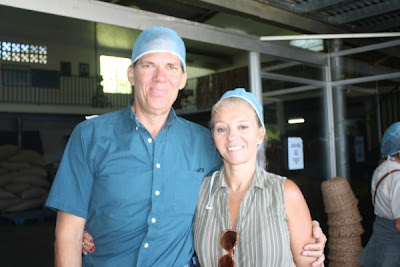On a recent road trip to Boquete with friends, Clyde and I had the pleasure of visiting Cafe Ruiz. Being a tea-toatler my whole life, I was not overly thrilled about touring a coffee farm. But after spending over 3 hours with our guide Carlos, I was truly fascinated by the whole process and even enjoyed the tasting at the end.
Our tour begin in the field with Carlos as he picked a handful of red cherry-like fruits from a small tree. Coffee is actually a fruit and in each red coffee fruit are two beans. Carlos squeezed the fruit and the two yellowish beans appeared. He popped one into his mouth as he explained that they taste sweet when sucked on, but can't be chewed, just sucked and spit out. He passed some fruits around so we could all have the experience of sucking on the sweet beans.
Our Guide Carlos, also from the
Ngobe-Bugle tribe
Ngobe-Bugle tribe
The red fruits are hand picked
The coffee plants are planted alongside
all sorts of fruit tree, it helps to
all sorts of fruit tree, it helps to
keep the bugs off the coffee trees!
Coffee Trees
The first step to coffee making is hand picking the fruits. Since this happens to be harvesting season, we were lucky enough to see pickers in action. Most of the coffee pickers at Cafe Ruiz are indigenous people from the Ngobe-Bugle tribes. Children as young as age 10 are allowed to work in the fields during school vacations along-side their parents. Pickers are paid by the amount that they pick, and a good picker in Panamá can make $20.00 a day. Considering that minimum wage in Boquete is only $1.50 an hour, that's a pretty good days wages for the locals. Cafe Ruiz also provides housing for the workers during the harvest and even has a small store on the farm where they can shop. Carlos began as a picker many years ago and admits that it's very hard work. They work from 7am to 5pm, in hot sun and rain, deal with snakes and other critters, and carry heavy baskets of coffee beans on their backs.
Some of the women coffee pickers
Spreading the Beans
to dry in the sun
to dry in the sun
Worker shoveling the dried beans
Must dress like DORKS before being
allowed in Roasting / Packing area
allowed in Roasting / Packing area
Some of the original coffee roasters
Coffee Roaster in use today
Boquete has more expats that any other part of Panamá who enjoy the mountain vistas and cool spring-like temperatures. As more expats move into Boquete, the demand for housing increases as does the price of land. According to Carlos our guide, one hectare of land in Boquete sells for $350,000. Because coffee farmers cannot make that much money from one hectare of coffee farming in a lifetime, they are selling out to developers. As time goes by the coffee farms in Panamá are disappearing, as more and more gated communities of expats take over Boquete. Mr. Ruiz, the owner of this family institution has vowed to never sell his coffee farm. At the age of 91, Mr. Ruiz lives in a small house on the farm and still oversees the operation on a daily basis.
This is the simple home of the owner, Mr. Ruiz
This is some of the housing for the pickers
This little girl was at the "general store"
She is one of the children of the pickers
from the Ngobe-Bugle tribe
She is one of the children of the pickers
from the Ngobe-Bugle tribe
Our tour of the coffee farm was amazing and the highlight of our trip to Boquete. Perhaps I've never liked coffee because I've never tried really good coffee. One of the lessons we learned at Cafe Ruiz is to never buy coffee already ground. Some suppliers grind up sticks, pulp and other fillers into their ground coffee. At the end of our tour was a coffee tasting and then we were each sent home with a one pound bag of Cafe Ruiz. So tomorrow we'll grind up some beans (48 for each cup) and perhaps I'll become a "coffee snob" here along the gringo trail.
End of tour with Carlos
Can you believe she is drinking coffee?




















Great blog! Makes me wonder how the coffee drink ever came to be invented at all! Course, that's in the category of wh had the courage to eat the first lobster!
ReplyDeleteLove your blog!
ReplyDelete